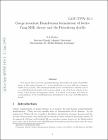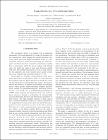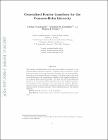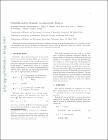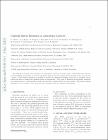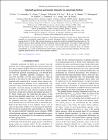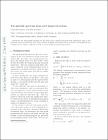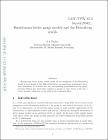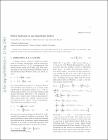Browsing Pure & Applied Mathematics by Title
Now showing items 144-163 of 390
-
Gauge invariant Hamiltonian formulation of lattice Yang-Mills theory
(World Scientific, 1995)It it known that to get the usual Hamiltonian formulation of lattice Yang-Mills theory in the temporal gauge A0 = 0 one should place on every link the cotangent bundle of a Lie group. The cotangent bundle may be considered ... -
Gauge theories on a 2+2 anisotropic lattice
(American Physical Society, 2003)The implementation of gauge theories on a four-dimensional anisotropic lattice with two distinct lattice spacings is discussed, with special attention to the case where two axes are finely and two axes are coarsely discretized. ... -
Gauge-string duality for (non)supersymmetric deformations of N=4 super Yang-Mills theory.
(Elsevier, 2005)We consider a non-supersymmetric example of the AdS/CFT duality which generalizes the supersymmetric exactly marginal deformation constructed in hep-th/0502086. The string theory background we use was found in hep-th/0503201 ... -
Gauge-string duality for superconformal deformations of N=4 super Yang-Mills theory.
(Institute of Physics, 2005)We analyze in detail the relation between an exactly marginal deformation of N = 4 SYM | the Leigh-Strassler or \?-deformation" | and its string theory dual (recently constructed in hep-th/0502086) by comparing energies ... -
Generalised Fourier transform for the Camassa-Holm hierarchy
(Institute of Physics, 2007)The squared eigenfunctions of the spectral problem associated to the Camassa-Holm equation represent a complete basis of functions, which helps to describe the Inverse Scattering Transform for the Camassa-Holm hierarchy ... -
Giant magnons in TsT-transformed AdS_5 x S^5
(IOP Publishing, 2008)We consider giant magnons propagating in a \gamma-deformed AdS_5 x S^5 background obtained from AdS_5 x S^5 by means of a chain of TsT transformations. We point out that in the light-cone gauge and in the infinite J limit ... -
Glueball matrix elements on anisotropic lattices
(Elsevier, 1998)We describe a lattice calculation of the matrix elements relevant for glueball production in J/ radiative decays. The techniques for such a calculation on anisotropic lattices with an improved action are outlined. We ... -
Glueball matrix elements on anisotropic lattices
(Elsevier, 2004)The glueball-to-vacuum matrix elements of local gluonic operators in scalar, tensor, and pseudoscalar channels are investigated numerically on several anisotropic lattices with the spatial lattice spacing in the range ... -
Glueball spectrum and matrix elements on anisotropic lattices
(American Physical Society, 2006)The glueball-to-vacuum matrix elements of local gluonic operators in scalar, tensor, and pseudoscalar channels are investigated numerically on several anisotropic lattices with the spatial lattice spacing ranging from ... -
Glueball spectrum from an anisotropic lattice study
(American Physical Society, 1999)The spectrum of glueballs below 4 GeV in the SU~3! pure-gauge theory is investigated using Monte Carlo simulations of gluons on several anisotropic lattices with spatial grid separations ranging from 0.1 to 0.4 fm. Systematic ... -
The glueball spectrum from novel improved actions
(Elsevier, 2000)Results for the inter-quark potential and low-lying SU(3) glueball spectrum from simulations using a new improved action are presented. The action, suitable for highly anisotropic lattices, contains a two-plaquette ... -
Green-Schwarz strings in TsT-transformed backgrounds.
(Institute of Physics, 2006)We consider classical strings propagating in a background generated by a sequence of TsT transformations. We describe a general procedure to derive the Green-Schwarz action for strings. We show that the U(1) isometry ... -
Hadron Scattering Amplitudes from Lattice QCD
(Trinity College Dublin. School of Mathematics. Discipline of Pure & Applied Mathematics, 2023)In this thesis we compute hadron scattering amplitudes within the framework of lattice quantum chromodynamics. Finite-volume spectra are computed using distillation and the variational method. These spectra constrain ... -
Hadron spectroscopy from lattice quantum chromodynamics
(2016)Lattice calculations of hadron spectroscopy are discussed. A brief introduction to numerical simulations of QCD, with a focus on spectroscopy is given. Results for spectroscopy of low-lying, excited and exotic states ... -
Haldane limits via Lagrangian embeddings
(Elsevier, 2012)In the present paper we revisit the so-called Haldane limit, i.e. a particular continuum limit, which leads from a spin chain to a sigma model. We use the coherent state formulation of the path integral to reduce the problem ... -
Hamiltonian lattice gauge models and the Heisenberg double
(World Scientific, 1995)Hamiltonian lattice gauge models based on the assignment of the Heisenberg double of a Lie group to each link of the lattice are constructed in arbitrary spacetime dimensions. It is shown that the corresponding generalization ... -
Heavy Hadron Spectroscopy from Lattice QCD
(Trinity College Dublin. School of Mathematics. Discipline of Pure & Applied Mathematics, 2024)In this thesis, heavy hadron spectroscopy was studied through the formalism of lattice quantum chromodynamics. A summary of relevant theory is provided, followed by an overview of the current state-of-the-art spectroscopy ... -
Heavy hadrons on an anisotropic lattice
(Elsevier, 2004)Results from simulations of quarkonia and heavy-light mesons on an anisotropic lattice are presented. The improved quark action and action-parameter tuning used in this study are discussed. -
Heavy quark physics from lattice QCD
(Elsevier, 2002)I review the current status of lattice calculations of heavy quark quantities. Particular emphasis is placed on leptonic and semileptonic decay matrix elements.




